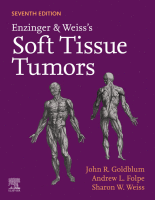Physical Address
304 North Cardinal St.
Dorchester Center, MA 02124

The neoplasms described in this comprehensive chapter are a heterogeneous group of tumors, having for the most part uncertain histogenesis and no known normal tissue counterpart. Each is characterized by its own distinctive clinical and pathologic features. These tumors can…

In previous editions of this textbook, several entities of uncertain type were placed into either benign or malignant categories. Although these entities still remain an enigma with regard to line of cellular differentiation, larger clinicopathologic studies of each of these…

This chapter discusses a heterogeneous group of benign tumors or pseudotumors, many of which are characterized by abundant myxoid stroma (intramuscular myxoma, juxta-articular myxoma, cutaneous myxoma, ganglion). Evidence indicates that the cells in these lesions are fibroblastic or have some…

Benign extraosseous cartilaginous lesions are uncommon and usually present as tumorlike masses. In the past, the term soft part chondroma or extraskeletal chondroma was used arbitrarily for small, well-defined, solitary nodules of hyaline cartilage that are unattached to bone and…

The overwhelming majority of human tumors showing melanocytic differentiation occur in the skin and represent benign melanocytic nevi, their variants, and malignant melanomas. However, a small percentage of tumors showing melanocytic differentiation occur in unusual locations, such as the meninges…

Peripheral neuroblastic tumors arising from the sympathoadrenal lineage of neural crest during development include neuroblastoma, ganglioneuroblastoma, and ganglioneuroma. Although some ganglioneuromas were once believed to arise independently of neuroblastoma, the International Neuroblastoma Pathology Committee now states that “all ganglioneuromas were…

Malignant Peripheral Nerve Sheath Tumor Malignant tumors arising from or displaying differentiation along the lines of the various elements of the nerve sheath (e.g., Schwann cell, perineurial cell, fibroblast) are collectively referred to as malignant peripheral nerve sheath tumors (MPNSTs).…

Benign peripheral nerve sheath tumors differ from other soft tissue tumors in several important respects. Most soft tissue tumors arise from mesodermally derived tissue and display a range of features consonant with that lineage. Nerve sheath tumors arise from tissues…

The synovial membrane forms the lining of joints, tendons, and bursae. In addition, its cells synthesize hyaluronate, a major component of synovial fluid, and facilitate the exchange of substances between blood and synovial fluid. The synovial membrane varies considerably in…

Perivascular tumors recapitulate the appearance of the modified myoid cells that support or invest blood vessels (i.e., glomus cell and pericyte). Sometimes referred to as perivascular myoid tumors, these include glomus tumor and its variants, myopericytoma, myofibroma/myofibromatosis, and sinonasal glomangiopericytoma…